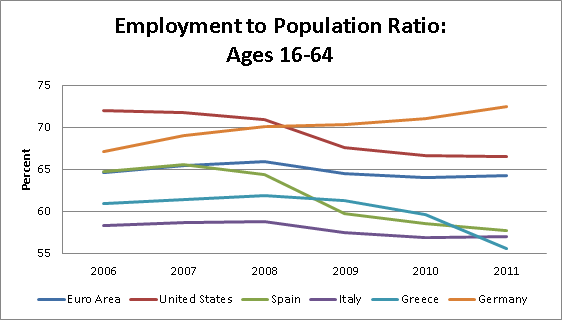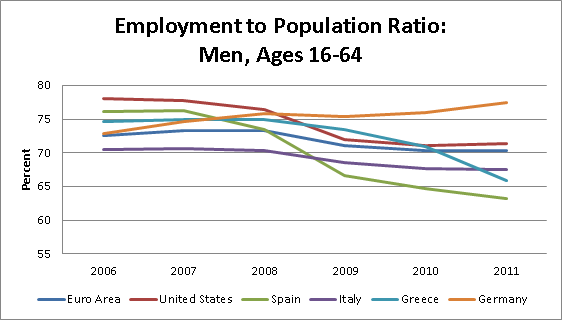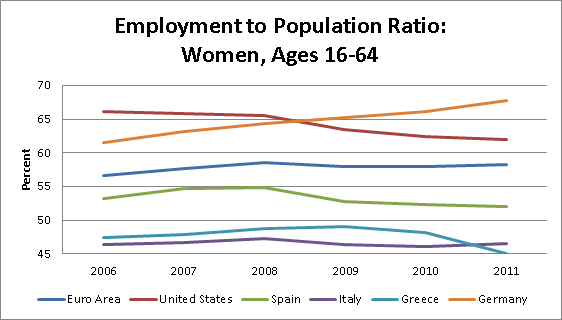March 24, 2013
As we get our latest dose of euro crisis thrills with the battle of the Cypriot banks, it might be a good time and step back to reflect on the havoc wreaked by the European Central bankers. While the double-digit unemployment rates throughout much of the region have grabbed headlines, if we flip the picture over and look at employment rates we see a somewhat more complicated picture.
First, if we look at employment population ratios for the adult population as a whole (ages 16-64), the euro zone story does not look especially dire.

Source: OECD.
If we want to do a direct comparison of employment population ratios (EPOP) for the euro zone as a whole, the relevant lines are the top line and the third line. In 2006 the United States had an EPOP for its adult population of 72.0 percent compared to 64.6 percent for the euro zone as a whole. By 2011 most of this gap had closed as the EPOP for the U.S. had dropped to 66.6 percent compared to 64.3 percent for the euro zone.
The closing of this gap is the story of two Europes. The north, led by Germany, has seen a rise in its EPOP since the downturn. While Germany had an EPOP in 2006 that was 4.8 percentage points below that of the U.S., in 2012 data (not on the chart), its EPOP was more than 6 pp higher.
By contrast, the crisis countries of the periphery have seen declines in their EPOPs, but considerably less than might be expected given the severity of their downturns. Italy’s EPOP had fallen by just 1.4 pp, from 58.4 percent in 2006 to 57.0 percent in 2011. The drops in Greece and Spain were larger through 2011, but still comparable to the decline in the United States. In Greece the drop in the EPOP was 5.4 pp and in Spain it was 7.1 pp. This compares to a drop in the U.S. of 5.4 pp. Through 2011, even in the crisis countries the picture does not look especially bad compared to that in the United States.
There is an important qualification to this story. In 2012 the EPOP in the U.S. began to rise modestly. By contrast it fell sharply in both Greece and Spain. The EPOP in the third quarter of 2012 in Greece (the last quarter for which the OECD has data) was 50.4 percent, 5.2 pp below its year-round average for 2011. The EPOP for Spain in the fourth quarter of 2012 was 54.6 percent, 3.1 pp below its year-round average for 2011. The employment situation in these crisis countries may not have looked much worse than the employment situation in the U.S. through 2011, but it certainly does now.
The other striking part of the story is the extent to which the employment falloff is a story of male workers.

Source:OECD.
While the drop in EPOPs for men in the U.S. from 2006 to 2011 is modestly larger than the overall drop, at 6.7 percentage points, it is much more severe in both Greece and Spain. In Greece the decline was 7.7 pp through 2011 with an additional decline 6.3 pp through the first two quarters of 2012 for a total fall of 14.0 pp. In Spain the drop was 12.9 pp through 2011, with a further decline of 3.9 pp through the fourth quarter of last year for a total fall of 16.8 pp.
By contrast, women do not seem to have been hit nearly as hard.
 Source: OECD.
Source: OECD.
As is the case with men, the EPOP for women in Germany rises substantially over this period, going from 61.5 percent in 2006 to 67.7 percent in 2011. It continued to rise to 68.1 percent in the third quarter of 2012. The EPOP for women in the euro zone as a whole also showed a modest rise in this period, going from 56.6 percent in 2006 to 58.2 percent in 2011. By contrast, the EPOP for women in the United States fell by 4.1 pp over this period.
Interestingly, even in Greece and Spain the EPOP for women showed only a modest decline, dropping by 2.3 pp in Greece and just 1.2 pp in Spain. However as was the case with men, it seems the situation worsened notably in 2012. The EPOP for women had fallen by another 2.9 pp in Greece through the third quarter of 2012 and by 2.1 pp in Spain through the fourth quarter of 2012.
There are a couple of important takeaways from this picture. First, even in the hardest hit countries the drop in employment was not notably worse than in the United States through 2011. The better situation for women largely made up for a worse situation for men, compared with the picture in the United States. That is not necessarily entirely positive. If women who had preferred not to enter the labor force ending up taking low paying jobs because their husbands were unemployed, this is not a good story. However it means that the hardship may not be as severe as the unemployment data indicate.
The other really big takeaway is that 2012 was much worse than 2011. The fact that Greece, Spain and other crisis countries were able to endure the pain through 2011 does not imply that they will be able to endure 2012 level pain for an indefinite period of time. One hopes for evidence of intelligent life at the European Central Bank.






